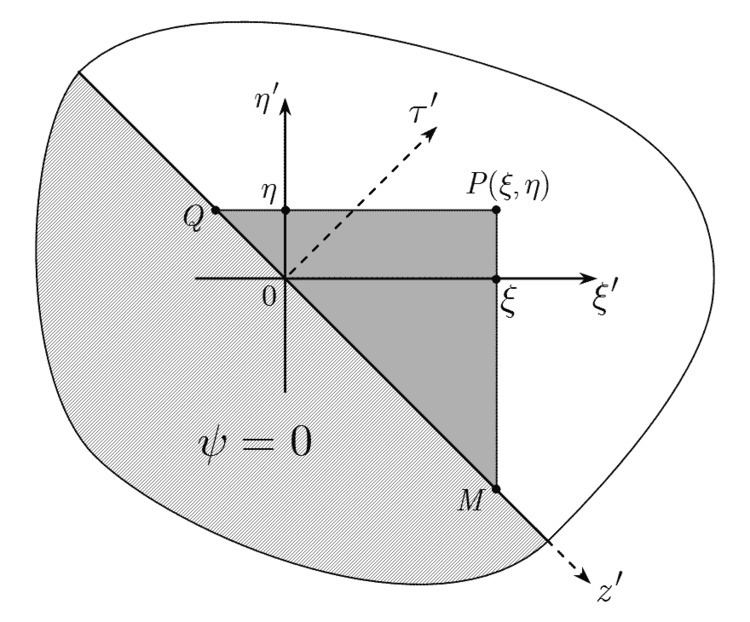 | ||
In physics and mathematics, the spacetime triangle diagram (STTD) technique, also known as the Smirnov method of incomplete separation of variables, is the direct space-time domain method for electromagnetic and scalar wave motion.
Contents
Basic stages
- (Electromagnetics) The system of Maxwell's equations is reduced to a second-order PDE for the field components, or potentials, or their derivatives.
- The spatial variables are separated using convenient expansions into series and/or integral transforms—except one that remains bounded with the time variable, resulting in a PDE of hyperbolic type.
- The resulting hyperbolic PDE and the simultaneously transformed initial conditions compose a problem, which is solved using the Riemann–Volterra integral formula. This yields the generic solution expressed via a double integral over a triangle domain in the bounded-coordinate—time space. Then this domain is replaced by a more complicated but smaller one, in which the integrant is essentially nonzero, found using a strictly formalized procedure involving specific spacetime triangle diagrams (see, e.g., Refs.).
- In the majority of cases the obtained solutions, being multiplied by known functions of the previously separated variables, result in the expressions of a clear physical meaning (nonsteady-state modes). In many cases, however, more explicit solutions can be found summing up the expansions or doing the inverse integral transform.
STTD versus Green's function technique
The STTD technique belongs to the second among the two principal ansätze for theoretical treatment of waves — the frequency domain and the direct spacetime domain. The most well-established method for the inhomogeneous (source-related) descriptive equations of wave motion is one based on the Green's function technique. For the circumstances described in Section 6.4 and Chapter 14 of Jackson's Classical Electrodynamics, it can be reduced to calculation of the wave field via retarded potentials (in particular, the Liénard–Wiechert potentials).
Despite certain similarity between Green's and Riemann–Volterra methods (in some literature the Riemann function is called the Riemann–Green function ), their application to the problems of wave motion results in distinct situations:
and it was the Riemann–Volterra representation that Smirnov used in his Course of Higher Mathematics to prove the uniqueness of the solution to the above problem (see, item 143).
are invoked. The Riemann-Volterra approach presents the same or even more serious difficulties, especially when one deals with the bounded-support sources: here the actual limits of integration must be defined from the system of inequalities involving the space-time variables and parameters of the source term. However, this definition can be strictly formalized using the spacetime triangle diagrams. Playing the same role as the Feynman diagrams in particle physics, STTDs provide a strict and illustrative procedure for definition of areas with the same analytic representation of the integration domain in the 2D space spanned by the non-separated spatial variable and time.
Drawbacks of the method
General considerations
Several efficient methods for scalarizing electromagnetic problems in the orthogonal coordinates
For the problems of wave motion is free space, the basic method of separating spatial variables is the application of integral transforms, while for the problems of wave generation and propagation in the guiding systems the variables are usually separated using expansions in terms of the basic functions (modes) meeting the required boundary conditions at the surface of the guiding system.
Cartesian and cylindrical coordinates
In the Cartesian
Here
The above problem possesses known Riemann function
where
Passing to the canonical variables
Rotation of the STTD 45° counter clockwise yields more common form of the STTD in the conventional spacetime
For the homogeneous initial conditions the (unique) solution of the problem is given by the Riemann formula
Evolution of the wave process can be traced using a fixed observation point (
More useful and sophisticated STTDs correspond to pulsed sources whose support is limited in spacetime. Each limitation produce specific modifications in the STTD, resulting to smaller and more complicated integration domains in which the integrand is essentially non-zero. Examples of most common modifications and their combined actions are illustrated below.
Spherical coordinates
In the spherical coordinate system — which in view of the General considerations must be represented in the sequence
where
known to have the Riemann function
where
Equivalence of the STTD (Riemann) and Green's function solutions
The STTD technique represents an alternative to the classical Green's function method. Due to uniqueness of the solution to the initial value problem in question, in the particular case of zero initial conditions the Riemann solution provided by the STTD technique must coincide with the convolution of the causal Green’s function and the source term.
The two methods provide apparently different descriptions of the wavefunction: e.g., the Riemann function to the Klein–Gordon problem is a Bessel function (which must be integrated, together with the source term, over the restricted area represented by the fundamental triangle MPQ) while the retarded Green's function to the Klein–Gordon equation is a Fourier transform of the imaginary exponential term (to be integrated over the entire plane
Extending integration with respect to
Using formula 3.876-1 of Gradshteyn and Ryzhik,
the last Green's function representation reduces to the expression
in which 1/2 is the scaling factor of the Riemann formula and
